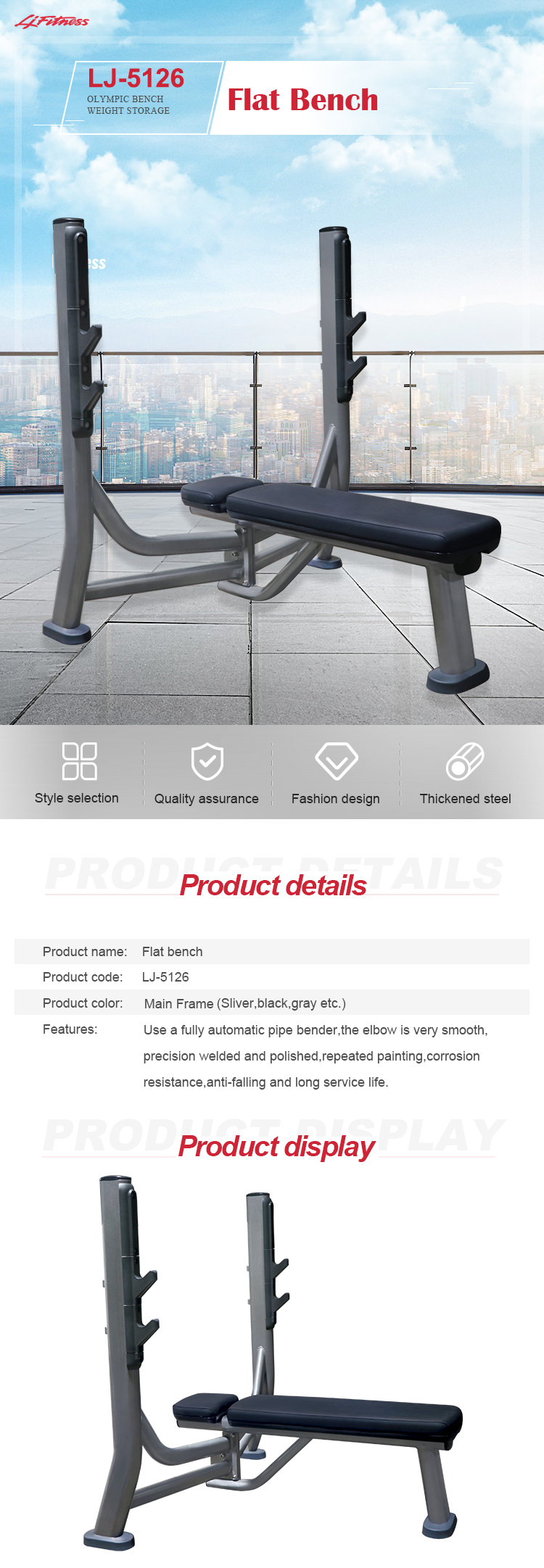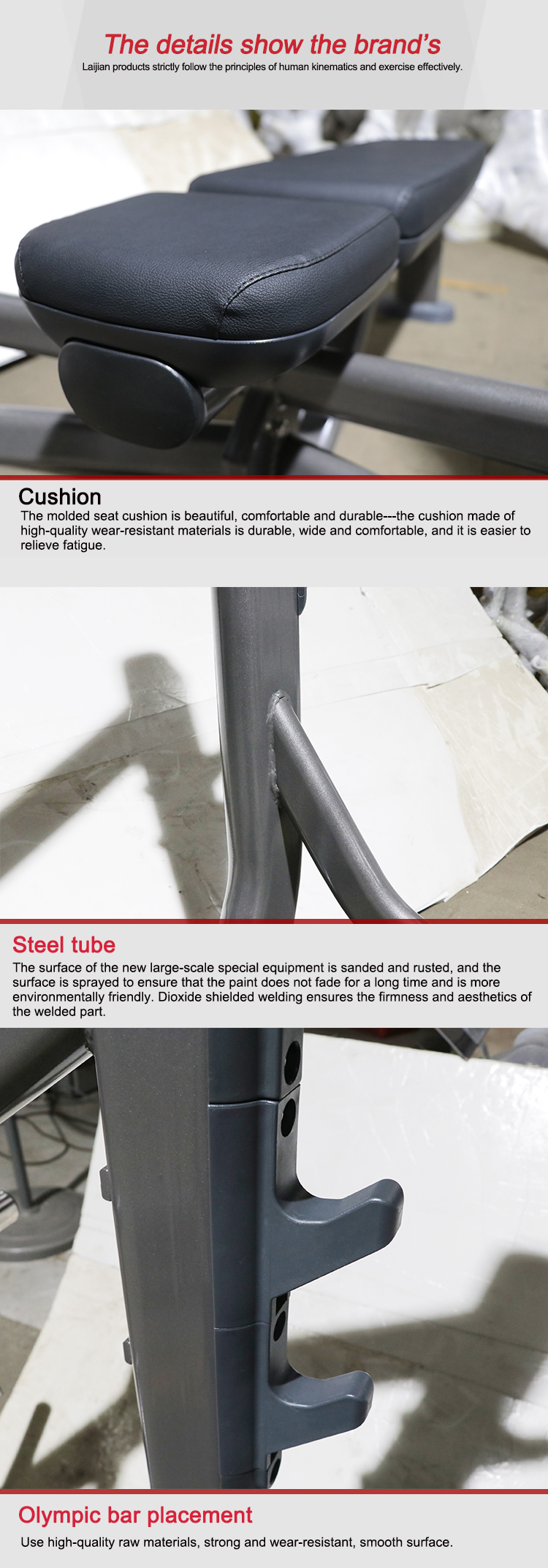A flat bench refers to a type of weightlifting bench that is flat and does not have an adjustable incline or decline. It is typically used for exercises such as bench press, dumbbell press, and various other upper body exercises. The flat surface allows for stability and a full range of motion during these exercises.
The flat bench press is a common weightlifting exercise that targets the chest muscles, shoulders, and triceps. It can be performed using a barbell or dumbbells, but there are also gym workout machines specifically designed for bench pressing.
The flat bench press machine typically consists of a flat bench attached to a frame with a weight stack or plate-loaded system. The user lies down on the bench and pushes the weight away from their chest, extending their arms fully and then lowering the weight back down.
To use the flat bench press machine, follow these steps:
1. Adjust the seat height and position the bench so that the bar or handles are at chest level when you lie down.
2. Sit on the machine and position yourself with your back flat against the bench and your feet planted firmly on the ground.
3. Grasp the handles or bar with an overhand grip, slightly wider than shoulder-width apart.
4. Take a deep breath, brace your core, and lift the weight off the rack or unhook it from the safety pins.
5. Lower the weight slowly towards your chest, keeping your elbows at a 45-degree angle to your body.
6. Pause briefly when the weight touches your chest, and then push it back up to the starting position, fully extending your arms.
7. Repeat for the desired number of repetitions.
It's important to use proper form and technique when using the flat bench press machine to avoid injury. Start with a weight that you can comfortably lift for your desired number of repetitions, and gradually increase the weight as you get stronger. Always warm up before starting your workout and consult a fitness professional if you're unsure about the correct technique.
How much stronger are you on flat bench?
My strength is in processing and generating text based on the knowledge I've been trained on. If you have any questions related to fitness, training, or advice, I can provide information and guidance to the best of my ability.
ls flat bench easier than decline?
The ease of performing a flat bench press compared to a decline bench press largely depends on the individual's fitness level, muscle strength, and biomechanics. Both exercises target the same primary muscles, which are the pectoralis major (chest), anterior deltoids (front shoulder), and triceps brachii (triceps).
1. Flat Bench Press: This is the most common bench press variation, where the backrest is parallel to the floor. For beginners or those with weaker chest muscles, the flat bench can be easier as there's less strain on the lower back. The angle is more straightforward, making it simpler to maintain proper form.
2. Decline Bench Press: In this exercise, the backrest is positioned at an angle, usually around 15-45 degrees, which places more emphasis on the upper chest and triceps. It can be more challenging for those who are new to bench pressing or have weaker upper body strength, as it requires better core stability and control. However, some individuals may find it easier once they've built up their chest muscles and learned how to control their movement.
In summary, a flat bench press might be easier for someone new to weight training or with a weaker upper body, while a decline press could be more challenging initially due to the increased angle and required stability. As you progress and build strength, both exercises can become more manageable, and the difficulty will depend on your personal capabilities. It's essential to start with a comfortable angle and focus on proper form to avoid injury.
ls it worth buying a weight bench for home?
Whether or not it's worth buying a weight bench for home depends on several factors, including your fitness goals, the type of workouts you plan to do, available space, and budget. Here are some points to consider:
1. **Fitness Goals**: If you're serious about strength training, weightlifting, or bodyweight exercises, a weight bench can be an excellent investment. It allows you to perform various exercises like bench presses, squats, and dips, which are essential for building muscle and improving overall strength.
2. **Home Workout Routine**: If you regularly engage in resistance training at home, a weight bench will provide the necessary equipment to support your workouts. It saves you from constantly borrowing or using
Gym Equipment.
3. **Space**: Weight benches can take up a fair amount of space, so ensure you have enough room in your home gym or workout area. If space is limited, consider a more compact model or one that can be easily stored when not in use.
4. **Budget**: Weight benches can range from affordable options to high-end, professional-grade models. Consider your budget and whether the benefits justify the cost. You might find more affordable alternatives like adjustable dumbbells or kettlebells that can still provide a good workout.
5. **Functionality**: Some weight benches come with additional features like leg extensions, preacher curls, or incline/decline adjustments. Evaluate your needs and choose a bench that offers the exercises you want to do.
6. **Durability**: Look for a bench made of sturdy materials that can withstand regular use and maintain its quality over time.
In summary, if you have a consistent workout routine that includes strength training, a weight bench can be a valuable addition to your home gym setup. It just depends on your specific needs, goals, and resources.
Does flat bench build muscle?
Yes, a flat bench press can definitely help build muscle, particularly in the chest, shoulders, and triceps. The flat bench press is a compound exercise that engages multiple muscle groups, making it an effective component of a well-rounded strength training program.
When performed with proper form and progressive overload (increasing weight over time), the flat bench press stimulates muscle growth through resistance training. It primarily targets the pectoralis major (chest muscles), anterior deltoids (front shoulder muscles), and triceps brachii (back of the upper arm). However, it also engages other muscles like the anterior and posterior parts of the deltoids, the upper back, and the core for stability.
To maximize muscle building, make sure to include appropriate warm-up, use a challenging weight, maintain good technique, and allow for adequate recovery between workouts. Additionally, incorporating variations such as incline, decline, or close-grip bench presses can target different aspects of these muscle groups, providing a more comprehensive workout. Don't forget to balance your training with other exercises and proper nutrition to support muscle growth.
What is a good flat bench press weight?
The appropriate flat bench press weight for you depends on various factors, including your fitness level, experience, goals, and form. Here's a general guideline to help you determine a good starting point:
1. **Experience**: If you're a beginner, start with a weight that you can handle comfortably for 8-12 repetitions with proper form. This could be around 40-50% of your estimated one-repetition maximum (1RM). As you progress, you can gradually increase the weight.
2. **Fitness Level**: For intermediate lifters, aim for a weight that allows you to perform 6-8 repetitions with good form. This might be around 60-75% of your 1RM. Advanced lifters may use weights closer to their 1RM or heavier, aiming for 4-6 repetitions.
3. **Goals**: If your goal is hypertrophy (muscle growth), focus on a weight that challenges you but still allows you to maintain proper form throughout the set, typically 60-80% of your 1RM. For strength training, you may choose a weight closer to your 1RM to challenge your max effort.
4. **Form**: It's crucial to prioritize proper technique over the amount of weight lifted. If you struggle with maintaining good form, it's better to use a lighter weight initially to ensure you're doing the exercise correctly.
Remember, these are just guidelines. You should always listen to your body and adjust the weight accordingly. Start low and gradually increase as you build strength and confidence. Additionally, consulting a certified personal trainer or coach can help you determine the right weight and progression plan for your specific needs.





